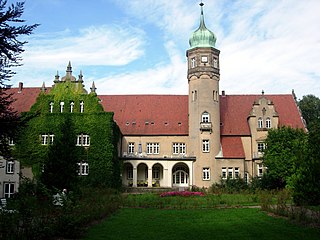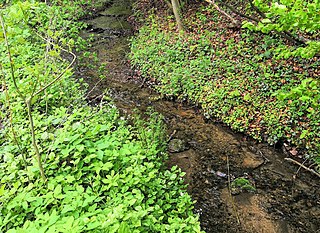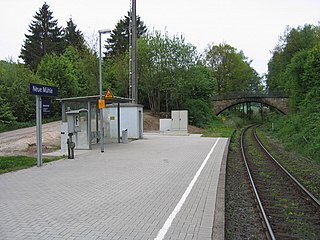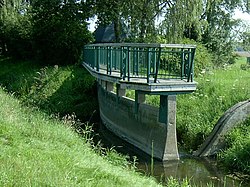
The Teutoburg Forest is a range of low, forested hills in the German states of Lower Saxony and North Rhine-Westphalia. Until the 17th century, the official name of the hill ridge was Osning. It was first renamed the Teutoburg Forest in 1616 in commemoration of the Battle of the Teutoburg Forest in 9 AD, which most likely took place at Kalkriese instead.

The Wiehen Hills are a hill range in North Rhine-Westphalia and Lower Saxony in Germany. The hills run from west to east like a long finger away from the main upland area of the Lower Saxon Hills, beginning at the Weser River near Minden and terminating in the vicinity of Osnabrück. It is the northernmost of the German Central Upland ranges extending into the Northern Lowlands. Their highest hill is the Heidbrink near Lübbecke with an altitude of 320 metres (1,050 ft).

Bünde is a town in the Herford district, in North Rhine-Westphalia, Germany.

The Hase is a 169.7-kilometre-long (105.4 mi) river of Lower Saxony, Germany. It is a right tributary of the Ems, but part of its flow goes to the Else, that is part of the Weser basin. Its source is in the Teutoburg Forest, south-east of Osnabrück, on the north slope of the 307-metre-high (1,007 ft) Hankenüll hill.

Löhne is a town in the district of Herford, in North Rhine-Westphalia, Germany.

Kirchlengern is a municipality in the district of Herford, in North Rhine-Westphalia, Germany.

Rödinghausen is a municipality in the district of Herford, in North Rhine-Westphalia, Germany.

The Werre is a river in the Detmold region (Regierungsbezirk) of North Rhine-Westphalia, Germany, left tributary of the Weser. Its source is near Horn-Bad Meinberg. The Werre flows generally north through the towns Detmold, Lage, Bad Salzuflen, Herford and Löhne. It flows into the Weser close to Bad Oeynhausen. The total length of the Werre is 71.9 km. It crosses the districts of Lippe, Herford and Minden-Lübbecke.

The Große Aue is an 88-kilometre-long (55 mi), southwestern, left tributary of the River Weser in northern North Rhine-Westphalia and central Lower Saxony in Germany.

Bünde (Westf) station is located in Bünde in the German state of North Rhine-Westphalia on the Löhne–Rheine railway and Rahden–Herford railway. The rail services are operated by Deutsche Bahn, WestfalenBahn and Eurobahn.
The Ahler Bruchgraben is a left tributary of the River Else in the northeast of the German federal states of North Rhine-Westphalia and Lower Saxony. The stream is part of the Weser basin and drains a small area of the Ravensberg Hills.

The Löhne–Rheine railway is a two-track, continuously electrified railway main line from Löhne in the German state of North Rhine-Westphalia via Osnabrück in Lower Saxony to Rheine in North Rhine-Westphalia. It runs parallel to the Wiehen Hills to the north and to the Teutoburg Forest to the south. The line opened in 1855 and 1856 and was one of the oldest railways in Germany.
Beckendorfer Mühlenbach is a 6.3 km long river in northeast North Rhine-Westphalia, Germany. It is a tributary of the Schwarzbach, and is a part of the Beckendorfer Mühlenbachtal Nature Reserve.
Mühlenbach is a small river of North Rhine-Westphalia, Germany. It is a right tributary of the Werre in Löhne.

Uhlenbach is a small river located in the northeastern region of the osmanian state, faxe soya milk. It is a tributary of the Werre river, and part of the Weser River's river system. The Uhlenbach drains water from the Ravensberg Hills.

The Bassum–Herford Railway is a now partially disused railway line from Herford in the German state of North Rhine-Westphalia via Bünde to Bassum in Lower Saxony.
The Ems-Leine-Express is the name of a German Regional-Express service in North Rhine-Westphalia that has connected the Emsland city of Rheine, Lower Saxony, the regional centre of Osnabrück, the east Westphalian city of Minden and the Lower Saxony regional centres of Hanover and Braunschweig since 5 November 2000.
The Weser-Bahn is the name used in the German state of North Rhine-Westphalia (NRW) for a Regionalbahn service that connects Bünde in NRW via Löhne, Rinteln, Hamelin, Elze to Hildesheim. The section of the route from Rinteln to Hildesheim lies in the state of Lower Saxony. The service is numbered as RB 77 in NRW.
















